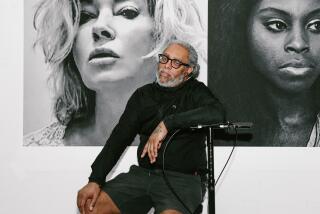A life of graceful improvisation
Amid the increasing popularity of Bollywood films, the fashions of India and fiction from the subcontinent, local audiences have a chance this week to see a man widely regarded as the supreme practitioner of a more rarefied mode of Indian artistic expression, the dance form known as kathak.
Birju Maharaj, now making a monthlong, seven-city U.S. tour, will bring his company of seven dancers and musicians to the Irvine Barclay Theatre on Tuesday.
At 65, Maharaj has spent a lifetime dazzling audiences from his native India to prestigious dance festivals in England, France, Germany, Russia and Canada. His first tour of the United States was 40 years ago, and in 15 visits -- including several Los Angeles appearances, the last in 1999 -- he has performed at Carnegie Hall three times.
Beate Gordon, former director of performing arts at the Asia Society in New York, has said, âBirju Maharaj is in the class of the great Western performers, such as Baryshnikov, Margot Fonteyn, Martha Graham and Merce Cunningham.â
What makes kathak so compelling? Originated more than 4,000 years ago by the Kathakas -- storytellers who pantomimed -- the art evolved into a full-blown dance form in the 16th century, when Mogul rulers and maharajahs started subsidizing it. And although India is home to several classical dance styles, including southern Indiaâs bharata natyam -- a more stylized and precise form -- kathak is beloved for its improvisational elements.
This spontaneity makes use of dizzying turns, complex footwork accentuated by hundreds of ankle bells, filigreed hand movements and dramatic facial expressions. Many dances are performed as narrative dramas based on Hindu mythology and poetry.
Add ornate costumes, a wall of percussive sound and virtuosic performers, and kathak might be appreciated even by die-hard MTV watchers, just as it is venerated in India today.
âA child who mesmerizesâ
While great dancers are usually made, not born, Maharaj no doubt came by some of his talent genetically. A native of Lucknow in northern India, he can trace his dance roots back many generations: His great-grandfather, his grandfather, two uncles and his father, with whom he began his training, were all dancers.
When he was born, he was given the name Brij Mohan -- Brij being the region, Mohan âa child who mesmerizes.â
Talking by phone from New York in heavily accented English, Maharaj recalls: âMy father, my teacher, told me, âDonât leave one day without the dance. You should stand and do some movements daily, and you can call it your food.â â
Today, he says, the gharana, or school, that he runs in New Delhi is known for its expressivity.
âThe beauty of the dance is the main focus. Everything is very mood-oriented,â he explains. âUnless there is beauty in the dance, it cannot be called dance. Lines should be graceful, and whatever rhythmic play is being done, even if itâs complex rhythms, itâs not just numbers -- mathematical calculations -- being performed.â
Observers have long remarked on Maharajâs grace, speed and agility, as well as the degree of detail he brings to his dancing. In his solo work, he often brings down the house -- especially when he is accompanied by master percussionist Zakir Hussain, who will join him as a guest artist for the Irvine engagement.
Saswati Sen, 50, who is also on this tour, has danced with Maharaj for three decades. She recalls a solo he performed several years ago in San Francisco, with Hussain accompanying.
âWe were waiting in the wings to go on, but they went on for two hours, and it was incredible. The whole program lasted over four hours, when we planned only a two-hour evening. People were going so crazy, they didnât want it to end. It was a real marathon.â
Is there rehearsal for such feats?
âNever,â Maharaj says with a hearty laugh. âZakir understands me very nicely. There are no restrictions. If I am going to Chicago and heâs coming from somewhere, I meet him in the green room for five minutes. What he will play and what I will do, we donât know.
âAs we start on stage, we will create -- spontaneously, immediately. My mood will come, and my blessing will come from my father, and the god will give me permission -- âGo and dance.â Then I will start. Before that I canât say.â
Committed to creating new works
As a choreographer, Maharaj has been an innovator. He was one of the first to create kathak group dances, 40 years ago, when many works in the idiom were either traditional or performed as solos, and he continues to make new works.
On the Irvine program -- in addition to Maharajâs two solos, a traditional invocation, âPanchatatva Stutiâ (a 10-minute work depicting natureâs five elements), and the finale, âMehfil,â -- audiences will see the contemporary âLoha (Autobiography of a piece of iron).â Sen says the 20-minute work was created as a response to todayâs turbulent times.
âBirju imagined that the piece of iron -- because [it] was compelled to become a weapon of destruction -- envies another piece of iron, which became a bell in a temple. In his own imagination, to Birju, some of the terrorists conceal their identities, conceal their faces, and because they fall into certain social situations that they never wanted, they go into bad things.â
Anjani Ambegaokar, whose Anjaniâs Kathak Dance of India has been a fixture on the local dance scene for 18 years, first met Maharaj in India in 1964, when she was 18 and selected as best dancer for a kathak festival in New Delhi. She too says he is one of the greats.
âWhen you see him, he is able to bring beauty and all aspects of his training and create this improvisation on stage. For his age, he looks amazing when he starts to dance.
âYou could watch him five or six times in the same piece,â Ambegaokar adds. âIâm sitting in awe, thinking, âWhat did he just do?â ... He has done so much for kathak.â
Although kathak may not spur the next âRiverdanceâ phenomenon, Sen agrees that it has grown in popularity. The style âhas become more accepted among the general masses,â she says. âIt has not only enriched in the technical parts, but Westerners have started to relish and appreciate the dance form.â
Maharaj, who has called New Delhi home for 40 years, counts two sons and a daughter among his students. For Deepak, 32, this tour marks his fourth with his fatherâs company. Male kathak dancers are the norm in India -- where gurus are male and women are expected to run the household -- but are less common in this country. Ambegaokar likens the situation to ballet, in which men are also in the minority.
Maharaj, who also plays percussion and sings, says he is still on a journey of discovery.
âDance is so vast that thereâs no end to learning and understanding,â he says. âI wish there was someone to teach me more. I know I can teach thousands, but I enjoy being a student so I can incorporate more knowledge.â Ask about retirement, and the master will have none of it.
âArtists are always thinking new things, and as you become old, more experience is coming. But it depends on the body. If the bodyâs not working, OK, I can say then I retire. If the body is working until 80, I should keep doing.â
*
Pandit Birju Maharaj and Company with Zakir Hussain
When: Tuesday, 8 p.m.
Where: Irvine Barclay Theatre, 4242 Campus Drive, Irvine
Price: $35 to $45
Contact: (949) 854-4646
More to Read
The biggest entertainment stories
Get our big stories about Hollywood, film, television, music, arts, culture and more right in your inbox as soon as they publish.
You may occasionally receive promotional content from the Los Angeles Times.










